Wisconsin has over 15,000 lakes, offering ample opportunity to cast a line as you wait for the day’s catch. The state has over 150 different fish species, including catfish, perch, and walleye. It has some of the best fishing lakes in the country, sharing a border with 1,000 miles of the Great Lakes shores. If you are older than 16 years old, you just need a fishing license to try your luck.
While the northern pike is one of the most popular fish within the state, the largest fish ever caught in Wisconsin is a lake sturgeon. Take a look to learn about the records for the heaviest fish that Wisconsin anglers have ever caught.
Records for the Largest Fish Ever Caught in Wisconsin
Lake Sturgeon – 212 lbs
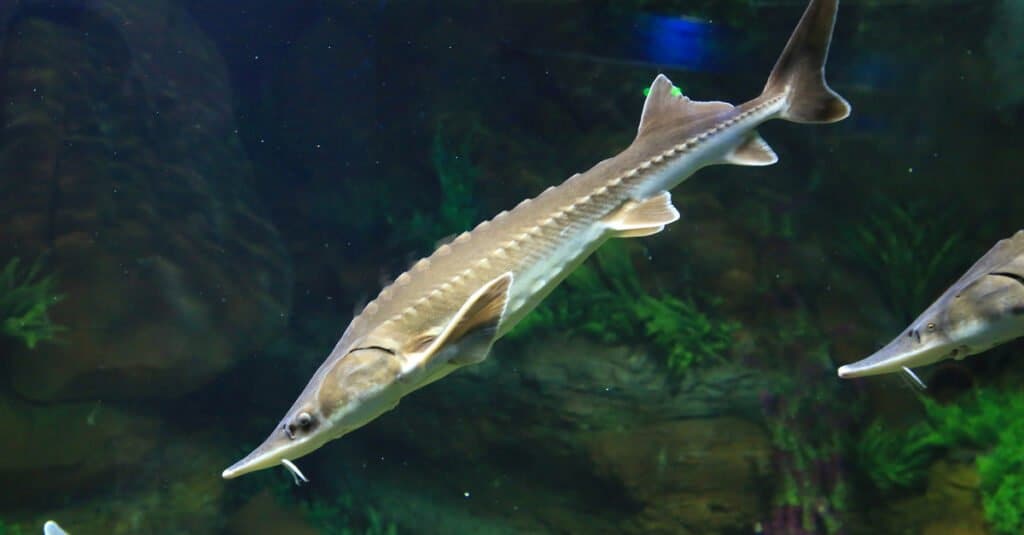
The lake sturgeon migrates with the seasons, which is why Wisconsinites need to keep an eye out for when it starts.
©Geermy/Shutterstock.com
- Method used: spear
- Angler: Ron Grishaber
The lake sturgeon is a massive species, primarily living in the Great Lakes around Wisconsin. It prefers freshwater, but it migrates to look for food or a place to spawn. Without being fished, the lake sturgeon sometimes lives to be 150 years old, though males usually only reach age 55. Also known as the rock sturgeon, it seeks out its food in substrate and sediment at the bottoms of lakes.
This particular catch was the result of spearfishing by Ron Grishaber. He caught the lake sturgeon on the opening day of sturgeon spearing season in 2010. The lake sturgeon measured 84.2 inches long and weighed 212.2 pounds. It surpassed the previous record – a lake sturgeon caught by Dave Piechowski that weighed 188 pounds and measured 79.5 inches. This species gets rather large, with some reaching over 7 feet in length, weighing over 240 pounds in some areas.
Lake Sturgeon – 170 lbs
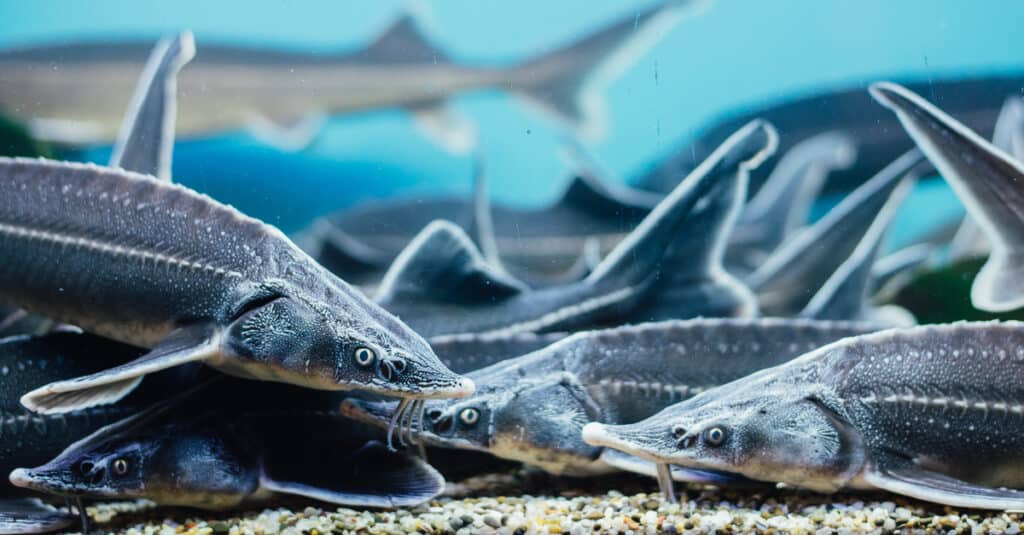
Lake sturgeons have a long lifespan, which is part of the reason that they are so large when caught.
©Stenko Vlad/Shutterstock.com
- Method used: fishing line
- Angler: John Procai
Lake sturgeons are rather popular in Wisconsin because of their distribution in the Great Lakes and Mississippi Rivers. Many fishermen seek them out, but Wisconsin only has a few areas that offer this opportunity. Black Lake is the easiest place to fish, though the previous lake sturgeon came from spearing season along Lake Winnebago.
Instead of using a spear, John Procai used the same method that many anglers on this list used – a fishing line – and he caught the fish at Yellow Lake. Procai’s lake sturgeon weighed 170.5 pounds, and he caught it in 1979. The reason that his fish was so notable, apart from its weight, was the age. According to a local newspaper, the Yellow Lake fish was about 100 years old, measuring 79 inches long. While friends of Procai caught fish of similar length, no verified catch with a fishing line is bigger than Procai’s sturgeon.
Bigmouth Buffalo – 94 lbs

Some of the other names of the bigmouth
buffalo
include the gourd-head, Marblehead, red-mouth buffalo, Bernard buffalo, or roundhead.
©USFWS Mountain-Prairie / CCO – License
- Method used: bow
- Angler: Brice Draeger
Bigmouth buffalo live across the entire North American continent, and it is the largest “sucker” fish in the region. It matures later than other freshwater fishes, which is part of why they can live to over a century old. They don’t reproduce as frequently as other freshwater fish but have no apparent age-related changes, even after living for 100 years. Some of its other names include the gourd-head, Marblehead, red mouth buffalo, Bernard buffalo, or roundhead.
Brice Draeger caught his record-breaking bigmouth buffalo with a bow in 2020. While his 94-pound fish set a new record for Wisconsin, it also established a BAA World Record, which has yet to be beaten.
Bigmouth Buffalo – 76 lbs
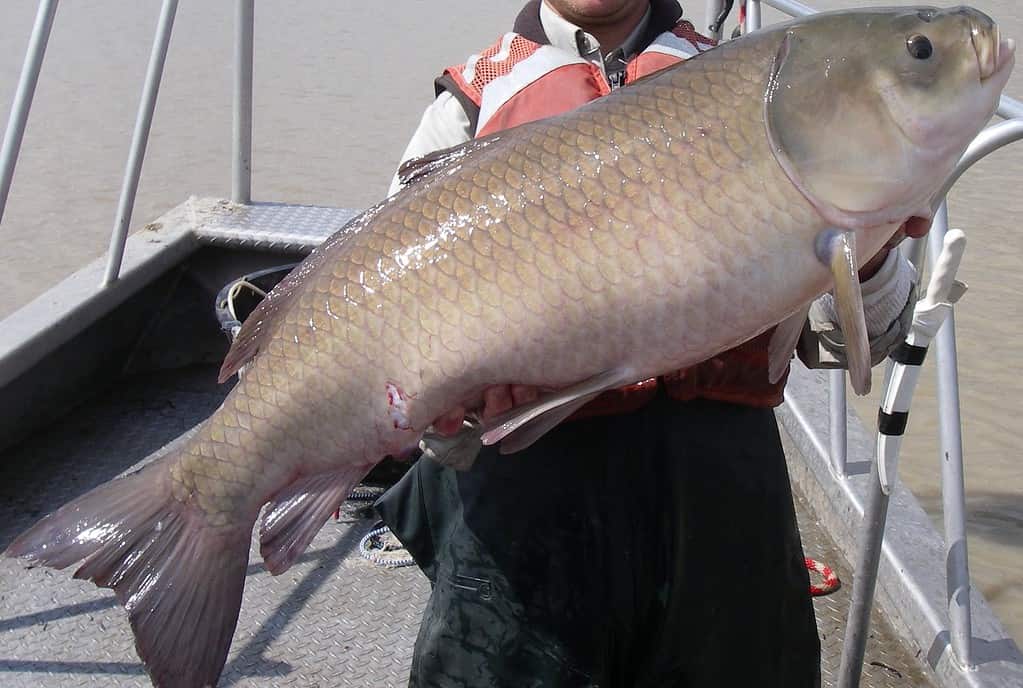
In the last assessment by the IUCN, the union didn’t believe that the fish was at risk of extinction, and there are no current efforts to conserve it.
©USFWS Mountain-Prairie / CC0 – License
- Method used: fishing line
- Angler: Noah Labarge
The bigmouth buffalo live in many rivers across the United States, which is how anglers catch them in North Dakota, Montana, Minnesota, Texas, Oklahoma, and Louisiana. When they are young, juvenile fish are one of the main sources of nutrients for predatory fish in the area. Unfortunately, many of the growing bigmouth buffalo fish are from old breeding with very few new juveniles.
While it is not unusual for it to grow rather large, the record for the 4th largest fish caught in Wisconsin is the bigmouth buffalo at 76.5 pounds. The fish measured 49.5 inches, caught by Noah Labarge, and he caught it at Devil’s Elbow on the Wisconsin River in 2013. All he needed was his 8-pound test line.
Flathead Catfish – 74 lbs
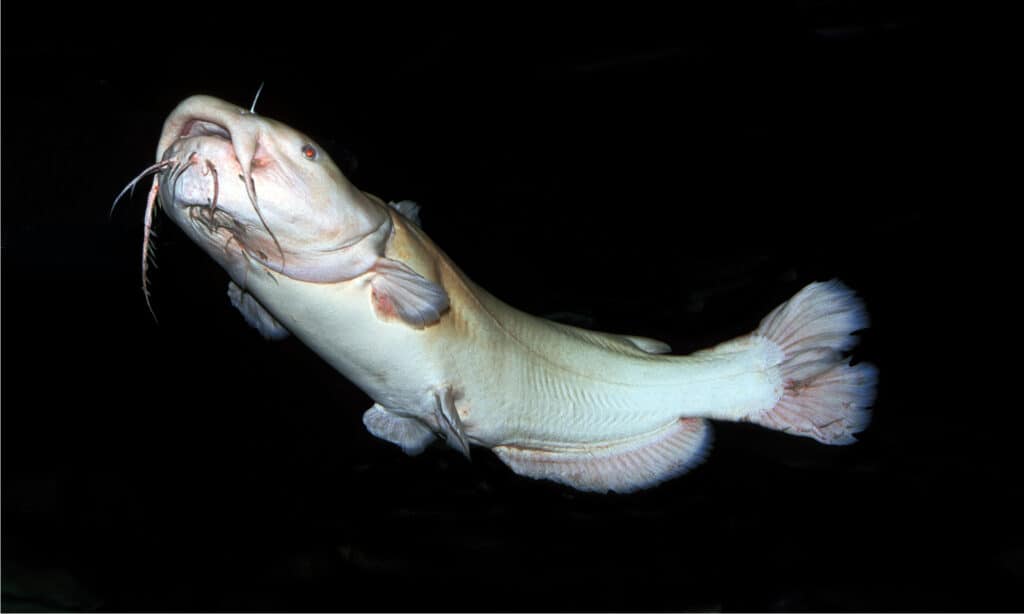
Flathead
catfish
eat whatever is available, making them easily susceptible to the bait of anglers.
©slowmotiongli/Shutterstock.com
- Method used: fishing line
- Angler: Stan Hagensick
Flathead catfish look just like others within the species, apart from the flat shape of their head. With whiskers around their mouth and no scales on their skin, their scientific name is a tribute to their simple body. The name comes from two words – the Greek word Pylodictus, which means “mudfish,” and the Latin word olivaris, which means “olive-colored.”
The flathead catfish that made waves as the 5th largest fish ever caught in Wisconsin is thanks to Stan Hagensick of Lynxville. In 2001, he caught a 74.5-pound flathead catfish on the Mississippi River. The fish measured 53 inches and used a similar 8-pound test line as Labarge did. By catching this flathead catfish, he surpassed the former record of 65 pounds.
Muskellunge – 69 lbs

Most fishermen seek out muskellunge if they want to get a trophy fish because of their popularity in Wisconsin.
©Engbretson, Eric / U.S. Fish and Wildlife Service, Public domain, via Wikimedia Commons – License
- Method used: fishing line
- Angler: Louis Spray
Muskellunge, frequently called muskies, are a type of predatory fish. As part of the pike family, the name comes from an Ojibwe word that translates to “ugly pike.” These fish look like many other pikes in the family, but they usually only weigh about 36 pounds as a full-grown adult. Most fishermen seek out muskellunge to get a trophy fish, seeking them out in northern areas in Wisconsin.
Louis Spray is the current holder of the record for catching a muskellunge, measuring 67 pounds, 11 ounces. He caught it back in 1949 from the Chippewa Flowage, but several anglers seemingly came close to his record. Art Lawton attempted to establish a new record in 1992 when he exaggerated the size of his catch. When the National Freshwater Fishing Hall of Fame and IGFA discovered the falsification with a true picture of the fish, they reestablished Spray’s 69-pound catch as the record holder.
Common Carp – 59 lbs

The common carp is also known as the European carp.
©Vladimir Wrangel/Shutterstock.com
- Method used: bow
- Angler: Zachary Seitz
This freshwater fish prefers to live in lakes and wide rivers. Despite a listed status of “vulnerable” by the IUCN, common carp continue to be fished as an invasive species. There are two main species, but the common carp lives fairly broadly worldwide. It is a major contributor to agriculture, but anglers in the United States don’t usually use it for food unless someone wants to cook the entire fish at once.
While many of the anglers on this list set records well into adulthood, Zachary Seitz stands out as one of the youngest record holders. While bow fishing with friend Nic Gerhartz late at night, he shot and released his arrow, securing him a 59-pound common carp in 2012. After passing every test by the Plymouth DNR, he managed to set this record before he even got his high school diploma.
Common Carp – 57 lbs

The common carp has a robust body and features glistening scales on all sides.
©Andrej Jakubik/Shutterstock.com
- Method used: fishing line
- Angler: Mike Porok
With a resilient tolerance of nearly any water, common carp tend to gravitate towards slow waters with vegetation in the sediment. They travel in groups, which means that catching them is fairly easy. They even swim easily in frozen-over lakes and ponds if there is still water to swim in.
Mike Porok set this next record by catching a 57-pound common carp in Lake Wisconsin in 1966. Since the size of the common carp is typically just 10 pounds, finding any carp of this size is a feat of its own.
Tiger Muskellunge – 51 lbs

Similar to other hybrid fish species,
tiger
muskies cannot reproduce.
©M Huston/Shutterstock.com
- Method used: fishing line
- Angler: John Knobla
The tiger muskellunge, or a tiger muskie, is a hybrid species of the muskie family, though its recognition as an official species didn’t happen until the 1930s. This type of fish eats other animals in freshwater areas, and it grows faster than a traditional muskellunge. They tend to be faster and stronger, and most weigh about 30 pounds. They have a reputation for posing a challenge to anglers, avoiding capture with great skill.
Even with the many records set through the years for muskies, John Knobla’s catch remains the biggest tiger muskellunge on record at 51 pounds. At the time, he won the 1919 Field & Stream contest, catching this whopper along the border between Wisconsin and Michigan. Several anglers sought to dethrone Knobla through the years, but this 54.5-inch muskie stands as one of the largest catches of the Badger State.
Flathead Catfish – 50 lbs

Since this variation of catfish tends to eat in the dark, you have the best odds of catching it during a night out.
©iStock.com/stammphoto
- Method used: bow
- Angler: Chris Hill
These catfish are unique because they are attracted to live fish as their main source of food, rather than scavenging their surroundings to eat. To catch them, live bait or something that looks like it is necessary, enticing them with fish like sunfish, carp, and shad. Adults live a solitary life, swimming in shallow waters after dark to find their food.
This is the second time a flathead catfish ranks among the largest fish ever to be caught in Wisconsin. Weighing 50 pounds, this record-setter was the result of angler Chris Hill’s work, catching it with the use of a bow instead of a fishing line. He caught the fish in 2020 in Poynette.
Lake Trout – 47 lbs
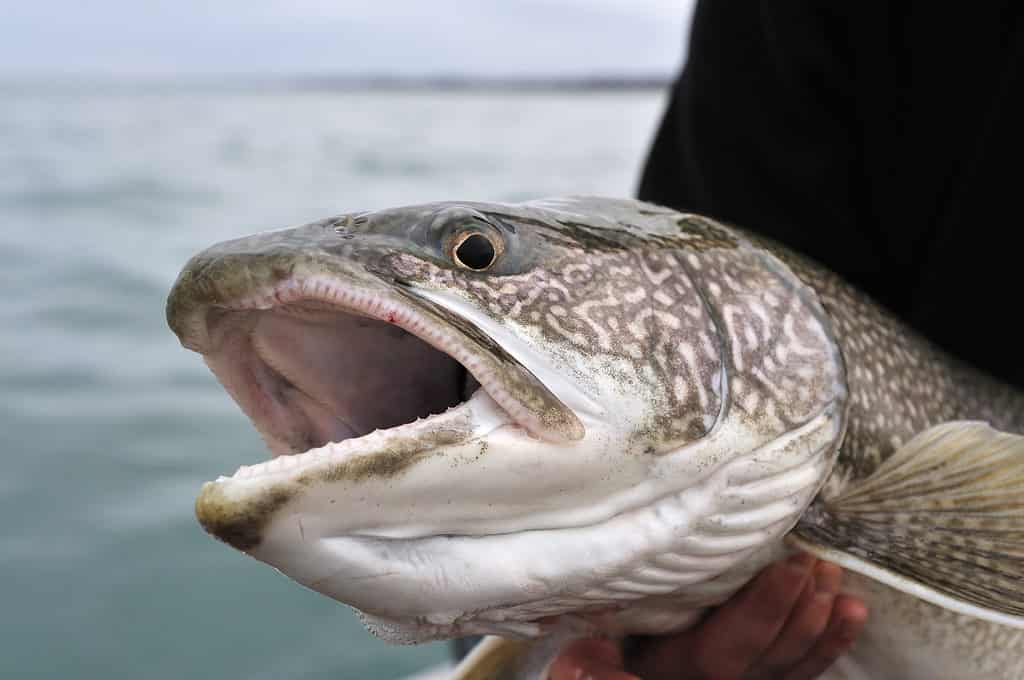
While lake trout are minimally distributed, they prefer cold and oxygen-rich water.
©iStock.com/glxedwards
- Method used: fishing line
- Angler: Waino Roose
Lake trout are a type of freshwater char spread throughout the northern area of North America. They mature late, but Lake Superior offers an excellent home to 2 of the 3 kinds of lake trout. These trout in Wisconsin prefer shallow areas, but their population dropped as lampreys increased their population and pollution started rising. Lake Superior allows lake trout fishing for commercial use by Ojibwe with certain restrictions.
Waino Roose caught his 47-pounder in Lake Superior in 1946. While others attempted to surpass this record, the only catch to come close was 11 years later, weighing only 35 pounds.
Grass Carp – 47 lbs
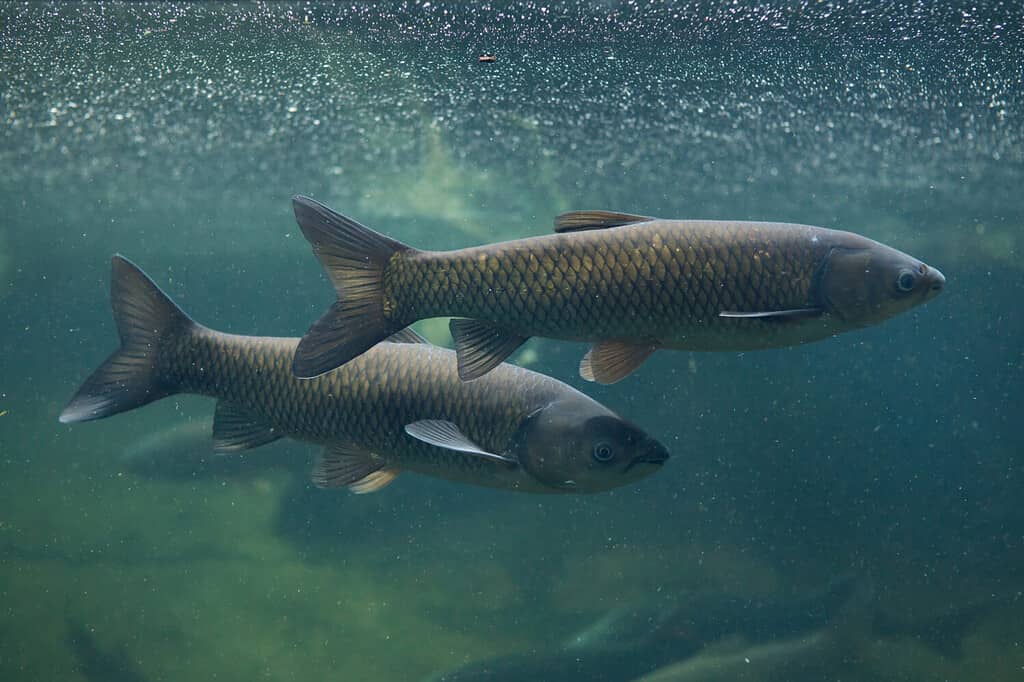
Most grass carp measure up to 40 inches, weigh under 100 pounds, and are no more than 6.6 feet long.
©Vladimir Wrangel/Shutterstock.com
- Method used: bow
- Angler: Brad Lamont
Grass carp are chubby but long. They have an herbivorous diet, living in freshwater areas where they were introduced in 1963 from Malaysia. At first, they only lived in Alabama and Arkansas, but the US Fish and Wildlife Service started the introduction to local bodies of water by the end of the 1960s. The first recorded reproduction happened in the Great Lakes Basin, helping to manage the overgrowth of local vegetation, giving them their name.
Brad Lamont set the record for this fish, catching his 47-pound grass carp in Darlington in 2019. While bow fishing on Platte River, he reeled in the 46.5-inch beauty, and no one has found a bigger grass carp yet.
Smallmouth Buffalo – 46 lbs
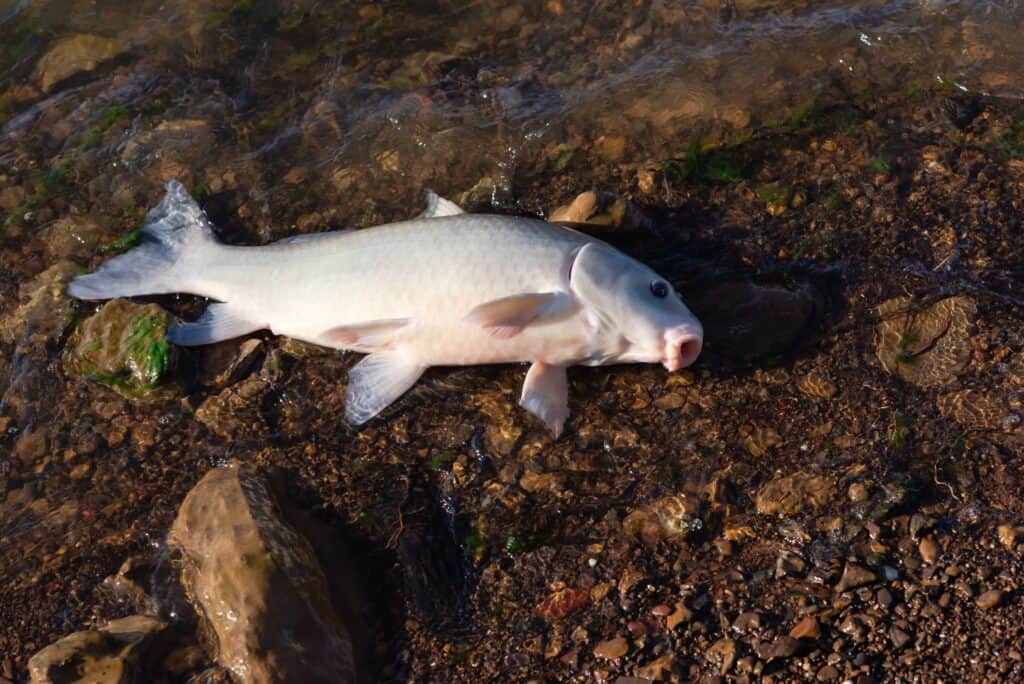
These fish are detritivores, which means that they eat dead plant material in the water.
©Trong Nguyen/Shutterstock.com
- Method used: bow
- Angler: Kevin Lakey
Smallmouth buffalo primarily lives in the Mississippi River, though a few areas also host it as an invasive species. It has a long life like bigmouth buffalo, but they usually weigh no more than 66 pounds at their biggest size. Some records show that these fish are as long as 40 inches with room to grow. They prefer fast-moving streams with beautiful clarity, making Wisconsin’s waters a perfect setting.
Kevin Lakely caught the next record on this list – a smallmouth buffalo that weighed 46 pounds – while bow fishing. He caught it directly from the Mississippi River in Trempealeau.
Chinook Salmon – 44 lbs
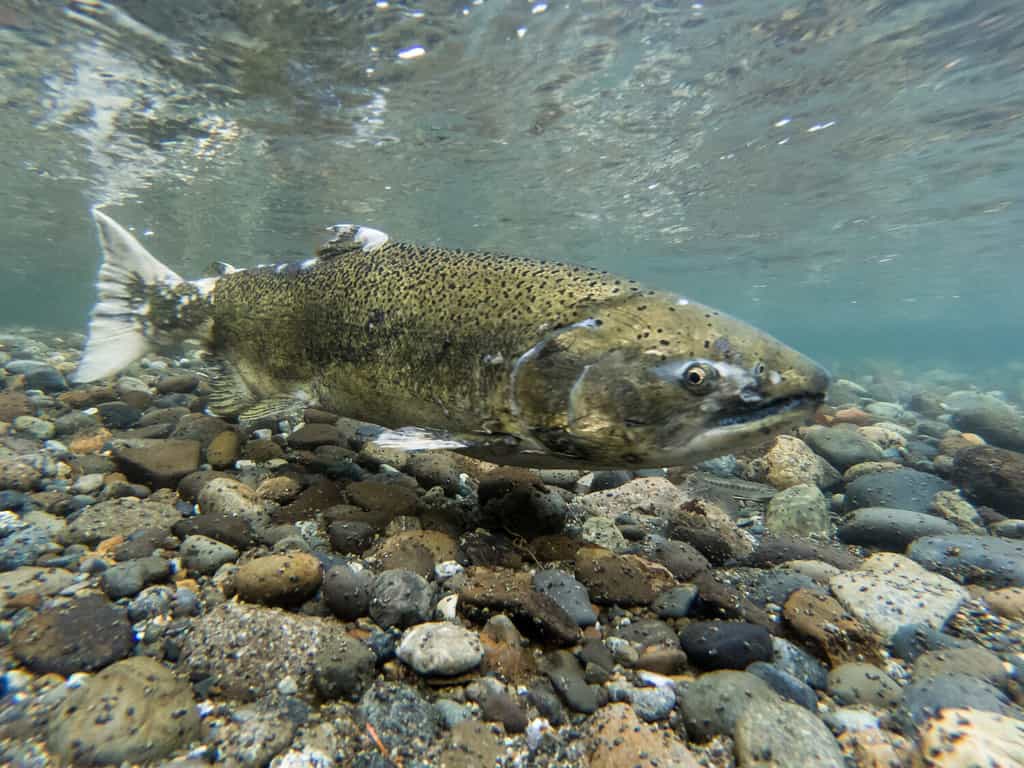
Chinook salmon usually weigh no more than 50 pounds, but some records show fish as big as 100+ pounds.
©Kevin Cass/Shutterstock.com
- Method used: fishing line
- Angler: Josh Bostedt
The Chinook salmon has many names, including the spring salmon, chrome hog, and Blackmouth. It has a thriving population in Lake Michigan, even though other populations outside of Wisconsin dropped with overfishing. It usually has a blue-green gleam, measuring up to 58 inches long.
The only person in Wisconsin to catch any chinook salmon of note is Josh Bostedt. Weighing just an ounce short of 45 pounds, Bostedt caught it while line fishing in Oconto in Lake Michigan.
Channel Catfish – 44 lbs

The average channel catfish weighs 2-4 pounds, but any angler is happy to see one over 20 pounds.
©Alauddin Abbasi/Shutterstock.com
- Method used: fishing line
- Angler: Larry Volenec
There is no species of catfish as abundant as the channel catfish. Established throughout the United States, it flourishes in the Great Lakes, where many Wisconsin anglers seek it out. They have an incredible sense of smell to easily find food wherever they are, even in muddy waters.
As the biggest channel catfish caught in Wisconsin, Larry Volenec holds the record at 44 pounds. He caught his trophy fish in 1962 in the Wisconsin River in Richland Center.
Records for the Largest Fish Ever Caught in Wisconsin
| Type of Fish | Weight | Angler | Year caught | Fishing Method |
| Lake sturgeon | 212 lbs. | Ron Grishaber | 2010 | spear |
| Lake sturgeon | 170 lbs. | John Procai | 1979 | fishing line |
| Bigmouth buffalo | 94 lbs. | Brice Draeger | 2020 | bow |
| Bigmouth buffalo | 76 lbs. | Noah Labarge | 2013 | fishing line |
| Flathead catfish | 74 lbs. | Stan Hagensick | 2001 | fishing line |
| Muskellunge | 69 lbs. | Louis Spray | 1949 | fishing line |
| Common carp | 59 lbs. | Zachary Seitz | 2012 | bow |
| Common carp | 57 lbs. | Mike Prorok | 1966 | fishing line |
| Tiger muskellunge | 51 lbs. | John Knobla | 2019 | fishing line |
| Flathead catfish | 50 lbs. | Chris Hill | 2020 | bow |
| Lake trout | 47 lbs. | Waino Roose | 1946 | fishing line |
| Grass carp | 47 lbs. | Brad Lamont | 2019 | bow |
| Smallmouth buffalo | 46 lbs. | Kevin Lakey | 2010 | bow |
| Chinook salmon | 44 lbs. | Josh Bostedt | 1994 | fishing line |
| Channel catfish | 44 lbs. | Larry Volenec | 1962 | fishing line |
The photo featured at the top of this post is © iStock.com/Matt Sampson Photography
Thank you for reading! Have some feedback for us? Contact the AZ Animals editorial team.






